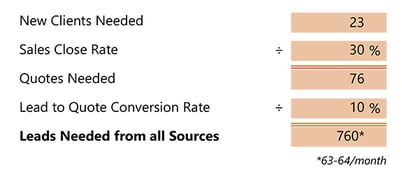

We know that in the manufacturing and industrial world, setting production goals, establishing quality metrics, and creating work instructions are a necessity. Unfortunately, it is not surprising to find companies in this space don’t treat their sales and marketing activities the same way they would their manufacturing or production environments. All too often, “more sales than last year” is the metric set. In order to establish an effective sales and marketing plan, you must first define your goals, determine the metrics needed to track the success of those goals, and create a plan to get there.
Let’s start with goal setting. Every company is different, so it is important that this is used as starting point for your thought process and can be adapted to fit your company’s needs.
Keep in mind that you should always be asking yourself, “are these goals realistic and achievable?”
- Have your past metrics indicated that you will be able to achieve this goal?
- If no, what will be different this time to make it happen? Will you set your team up for success by making new investments in this segment of your business?
- Do you have a process in place that will enable you to reach your goal?
- If no, this would be a good place to start. If you do not have a strong follow-up process in place for sales and marketing, it is very difficult to convert leads, no matter their quality or quantity.
- Do you have a budget?
- If you plan to grow, you may need to make an investment to allow for that to happen. For example, hiring an inside sales person, investing in inbound marketing, a new website, going to tradeshows, or other means to increase opportunities.
- Can your goal be accomplished in the time frame (your upcoming sales year)?
- Keep in mind, if you have a long sales cycle, it may not be achievable in the time available. You may need to focus on growing your opportunities in the pipeline this year and aim for revenue growth from those opportunities next year.
Here are the steps to setting realistic and achievable goals for your sales and marketing teams:
- Identify your previous period’s sales
numbers - Define your desired growth for the next sales cycle

- Calculate your Goal Revenue
- Take your previous sales goal and multiply by retention rate (Sales returning from the previous year)

- Subtract your retained sales from your sales goal to set your net new-business sales for the upcoming year

- Define your average new-business first-time sales. (What is the average sale worth for a new client in the first year?)
- Divide your new-business sales goal by average sales to determine how many new clients you will need

- Knowing that, divide the number of new clients by your quote-to-sales ratio. This will give you the number of quotes that you will need in the sales year to achieve your sales targets.
- For the final calculation, you need to know your lead-to-quote percentage. Use this number to calculate your needed lead goal. Divide your needed quotes by the lead-to-quote percentage and now you know how many leads you require.

Bottom line: Ask yourself “how many leads do I need to generate to seal the deal and hit my sales number?”
